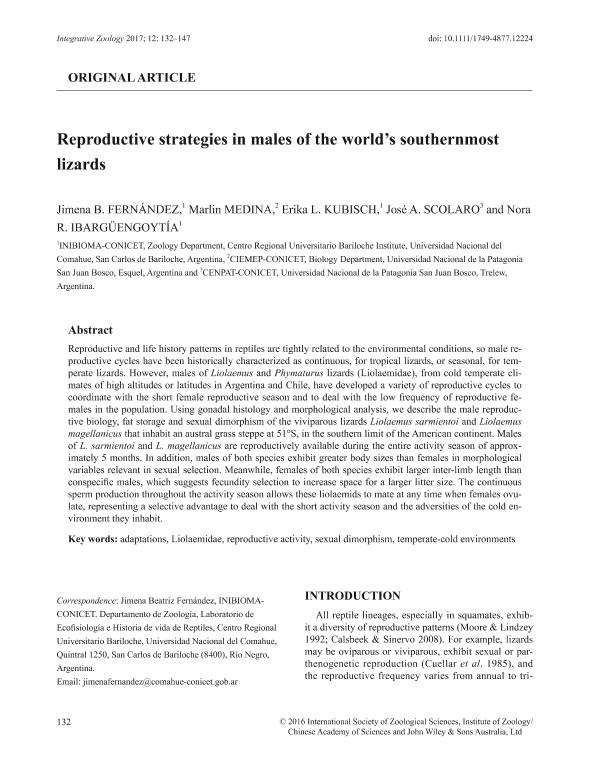Mostrar el registro sencillo del ítem
dc.contributor.author
Fernandez, Jimena Beatriz

dc.contributor.author
Medina, Susana Marlin

dc.contributor.author
Kubisch, Erika Leticia

dc.contributor.author
Scolaro, Jose Alejandro

dc.contributor.author
Ibarguengoytía, Nora

dc.date.available
2018-12-03T13:51:16Z
dc.date.issued
2017-03
dc.identifier.citation
Fernandez, Jimena Beatriz; Medina, Susana Marlin; Kubisch, Erika Leticia; Scolaro, Jose Alejandro; Ibarguengoytía, Nora; Reproductive strategies in males of the world’s southernmost lizards; Wiley-Blackwell; Integrative Zoology; 12; 2; 3-2017; 132-147
dc.identifier.issn
1749-4877
dc.identifier.uri
http://hdl.handle.net/11336/65569
dc.description.abstract
Reproductive and life history patterns in reptiles are tightly related to the environmental conditions, so male reproductive cycles have been historically characterized as continuous, for tropical lizards, or seasonal, for temperate lizards. However, males of Liolaemus and Phymaturus lizards (Liolaemidae), from cold temperate climates of high altitudes or latitudes in Argentina and Chile, have developed a variety of reproductive cycles to coordinate with the short female reproductive season and to deal with the low frequency of reproductive females in the population. Using gonadal histology and morphological analysis, we describe the male reproductive biology, fat storage and sexual dimorphism of the viviparous lizards Liolaemus sarmientoi and Liolaemus magellanicus that inhabit an austral grass steppe at 51°S, in the southern limit of the American continent. Males of L. sarmientoi and L. magellanicus are reproductively available during the entire activity season of approximately 5 months. In addition, males of both species exhibit greater body sizes than females in morphological variables relevant in sexual selection. Meanwhile, females of both species exhibit larger inter-limb length than conspecific males, which suggests fecundity selection to increase space for a larger litter size. The continuous sperm production throughout the activity season allows these liolaemids to mate at any time when females ovulate, representing a selective advantage to deal with the short activity season and the adversities of the cold environment they inhabit.
dc.format
application/pdf
dc.language.iso
eng
dc.publisher
Wiley-Blackwell
dc.rights
info:eu-repo/semantics/openAccess
dc.rights.uri
https://creativecommons.org/licenses/by-nc-sa/2.5/ar/
dc.subject
Adaptations
dc.subject
Liolaemidae
dc.subject
Reproductive Activity
dc.subject
Sexual Dimorphism
dc.subject
Temperate-Cold Environments
dc.subject.classification
Otras Ciencias Biológicas

dc.subject.classification
Ciencias Biológicas

dc.subject.classification
CIENCIAS NATURALES Y EXACTAS

dc.title
Reproductive strategies in males of the world’s southernmost lizards
dc.type
info:eu-repo/semantics/article
dc.type
info:ar-repo/semantics/artículo
dc.type
info:eu-repo/semantics/publishedVersion
dc.date.updated
2018-10-22T17:30:16Z
dc.journal.volume
12
dc.journal.number
2
dc.journal.pagination
132-147
dc.journal.pais
Reino Unido

dc.journal.ciudad
Oxford
dc.description.fil
Fil: Fernandez, Jimena Beatriz. Consejo Nacional de Investigaciones Científicas y Técnicas. Centro Científico Tecnológico Conicet - Patagonia Norte. Instituto de Investigaciones en Biodiversidad y Medioambiente. Universidad Nacional del Comahue. Centro Regional Universidad Bariloche. Instituto de Investigaciones en Biodiversidad y Medioambiente; Argentina
dc.description.fil
Fil: Medina, Susana Marlin. Consejo Nacional de Investigaciones Científicas y Técnicas. Centro Científico Tecnológico Conicet - Patagonia Norte. Centro de Investigación Esquel de Montaña y Estepa Patagóica. Universidad Nacional de la Patagonia "San Juan Bosco". Facultad de Ciencias Naturales - Sede Esquel. Centro de Investigación Esquel de Montaña y Estepa Patagónica; Argentina
dc.description.fil
Fil: Kubisch, Erika Leticia. Consejo Nacional de Investigaciones Científicas y Técnicas. Centro Científico Tecnológico Conicet - Patagonia Norte. Instituto de Investigaciones en Biodiversidad y Medioambiente. Universidad Nacional del Comahue. Centro Regional Universidad Bariloche. Instituto de Investigaciones en Biodiversidad y Medioambiente; Argentina
dc.description.fil
Fil: Scolaro, Jose Alejandro. Consejo Nacional de Investigaciones Científicas y Técnicas. Centro Científico Tecnológico Conicet - Centro Nacional Patagónico; Argentina
dc.description.fil
Fil: Ibarguengoytía, Nora. Consejo Nacional de Investigaciones Científicas y Técnicas. Centro Científico Tecnológico Conicet - Patagonia Norte. Instituto de Investigaciones en Biodiversidad y Medioambiente. Universidad Nacional del Comahue. Centro Regional Universidad Bariloche. Instituto de Investigaciones en Biodiversidad y Medioambiente; Argentina
dc.journal.title
Integrative Zoology
dc.relation.alternativeid
info:eu-repo/semantics/altIdentifier/doi/https://dx.doi.org/10.1111/1749-4877.12224
dc.relation.alternativeid
info:eu-repo/semantics/altIdentifier/url/https://onlinelibrary.wiley.com/doi/abs/10.1111/1749-4877.12224
Archivos asociados
